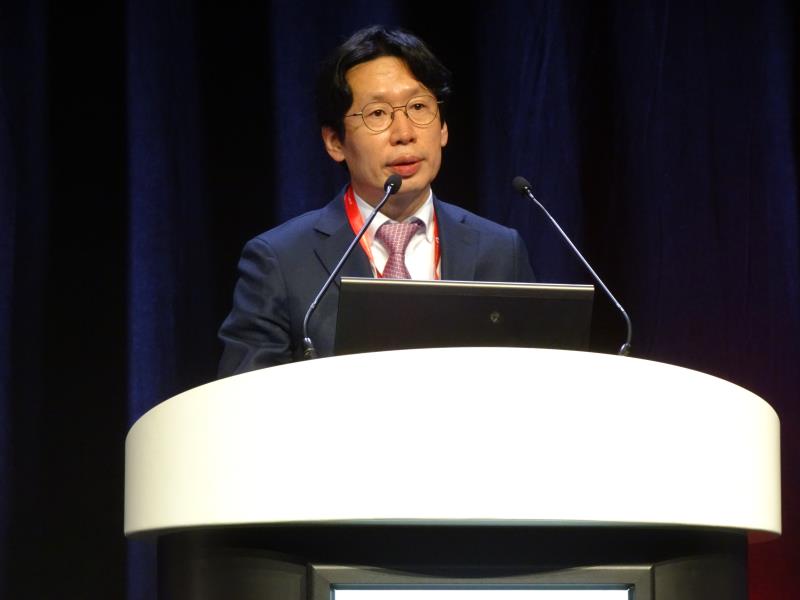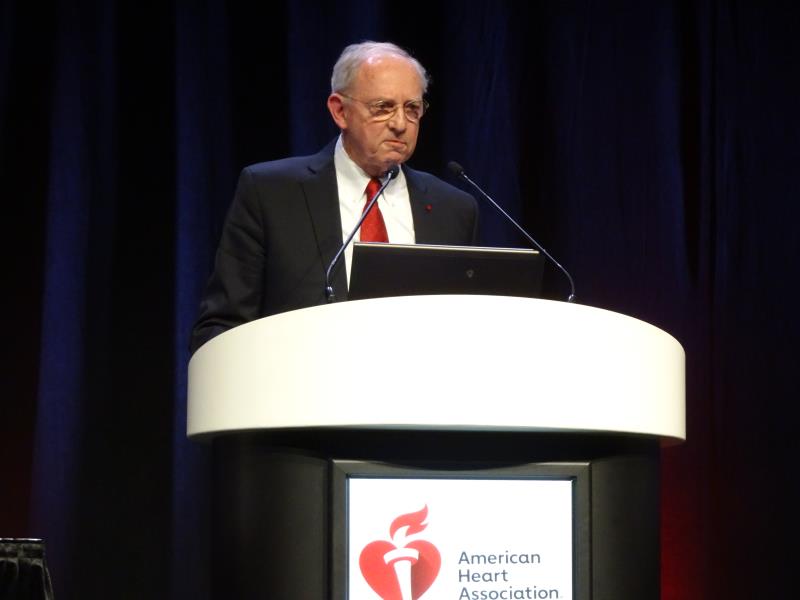 Dr Kang Duk Hyun
Dr Kang Duk HyunEarly aortic valve replacement (AVR) significantly lowered the risk of operative or cardiovascular (CV) death compared with conservative care in asymptomatic patients with very severe aortic stenosis (AS), according to the RECOVERY* trial presented at AHA 2019, thus providing support for early intervention before symptoms for valvular disease surface.
Current guidelines require that symptoms be present for consideration of AVR in patients with severe AS. For asymptomatic severe AS, the optimal timing for intervention remains controversial.
“[Conventionally,] watchful observation is recommended for the majority of asymptomatic patients, with AVR planned once symptoms develop,” said lead author Dr Kang Duk-Hyun from Asan Medical Center, Seoul, South Korea. “[This is because] in asymptomatic patients, the potential benefit of preventing sudden death [with AVR] may not be greater than the risk of [operative death associated with] AVR.”
However, recent advances in aortic-valve prostheses and surgical techniques may change the risk-to-benefit ratio of AVR, Kang noted.
Better early than wait
The incidence of the primary composite outcome of operative** or CV death during follow-up occurred in one patient among those who underwent early AVR surgery compared with 11 patients in the conservative care group (1 percent vs 15 percent; hazard ratio [HR], 0.09; p=0.003). [N Engl J Med 2020;doi:10.1056/NEJMoa1912846]
The secondary outcome of death from any cause during follow-up was similarly lower in the early surgery group vs the conservative care group (7 percent vs 21 percent; HR, 0.33; p=0.03), during a median follow-up of 6.2 years.
Per-protocol analysis also showed favourable results with early surgery over conservative care, consistent with the intention-to-treat analysis above.
“These benefits started early and persisted over 8 years, and — impressively — the number needed to treat to prevent one death from CV causes within 4 years was 20 patients,” highlighted Drs Patrizio Lancellotti and Mani Vannan from Centre Hospitalier Universitaire Sart-Tilman in Liege, Belgium and Piedmont Heart Institute in Atlanta, Georgia, US, respectively, in a linked editorial. [N Engl J Med 2020;doi:10.1056/NEJMe1914382]
“The RECOVERY trial provides the evidence for early pre-emptive AVR for asymptomatic severe AS,” said Kang.
In the multicentre, open-label trial, 145 asymptomatic patients (mean age 64 years) with very severe AS*** were randomized 1:1 to undergo early AVR surgery or conservative care. Patients in the early surgery group underwent AVR within 2 months after randomization. On the other hand, conservative care was based on recommendations from the ACC-AHA guidelines: watchful waiting until symptoms developed, if left ventricular ejection fraction dropped to <50 percent, or if peak aortic jet velocity increased annually by >0.5 m/second on echocardiography during follow-up.
“The decision to perform surgery in an asymptomatic patient requires careful weighing of the risks [and benefits] of early AVR against those of observation,” according to Kang and colleagues.
The researchers attributed the difference in long-term survival between groups to the substantially lower surgical risk of patients than in previous studies, and that early surgery might prevent sudden death, which became increasingly likely to occur with progression of AS in the conservative care group while waiting for symptoms to develop.
“[Also,] the overall risk of AVR appeared to increase while surgery was deferred until symptoms developed,” they noted.
How generalizable are the results?“In interpreting the trial results, it is important to take the patient population into account,” wrote Lancellotti and Vannan.
The population comprised patients with very severe AS (aortic velocity ≥4.5 m/second). “The risk–benefit ratio may be shifted toward a benefit of early surgery in this trial … because the risk of waiting increases according to the severity of AS,” explained the researchers. The benefit may be relatively smaller in asymptomatic patients with less severe AS, they suggested.
Unlike previous TAVR trials, RECOVERY enrolled relatively younger patients with lower operative risk and higher incidence of bicuspid aortic valve disease.
“[Thus,] the results of our trial cannot be directly applied to early TAVR for asymptomatic severe AS,” Kang and colleagues pointed out.
Also, as the operative mortality rate was very low in the current trial, the findings may not apply to patients at greater operative risk or lower-volume medical centres.
“Taken at face value, these results certainly confirm the unreliability of symptoms as a guide to the timing of surgery in patients with AS, especially in the elderly or when lifestyle adjustments or coexisting medical conditions limit activity or confound symptoms attributable to valvular disease,” commented Lancellotti and Vannan.
Similar points were raised by invited discussant Dr Robert Bonow of Northwestern University Feinberg School of Medicine in Chicago, Illinois, US, who asked: Were all patients truly asymptomatic?
“Would these excellent results … be transportable to the US in large centres where sometimes the operative mortality is not zero and we do indeed have the risks of stroke as we follow our patients?” he said.
“[The findings lead] to the question of how best to assess risk among patients with AS, formulate a follow-up plan, decide on the timing of intervention, and devise a management strategy,” Lancellotti and Vannan raised.
“Given that there appears to be a continuous increase in risk starting at a mean aortic-valve gradient of approximately 20 mm Hg, staging AS instead of classifying the valvular lesion only according to data from Doppler imaging appears to be the best approach,” they suggested.
 Dr Robert Bonow
Dr Robert Bonow